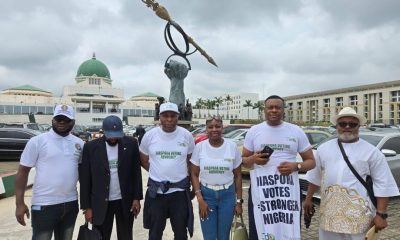NEWS
Nigerians Called To Cultivate Tree Planting To Fight Sand, Dust Storms

The Nigerian government has emphasised the importance of planting and nurturing trees to provide vegetation cover and protect farmlands from desert encroachment, particularly in the northeastern region of the country.
Dr. Iziaq Salako, Minister of State for Environment, stated during the celebration of International Sand and Dust Storm Day in Abuja, which is always observed on July 12, that the United Nations General Assembly designated the day as the International Day of Combating Sand and Dust Storms (SDS).
He stated that Sand and Dust Storms (SDS) are atmospheric phenomena that occur primarily in dry lands, but their effects can be seen far beyond drylands due to the long-range transportation of sand and dust, which primarily originate in arid, semi-arid, and dry subhumid areas.
According to him, the United Nations General Assembly’s proclamation of July 12th as the International Day of Combating Sand and Dust Storms aims to raise awareness about the catastrophic effects of sand and dust storms, as well as their causes, impacts, and preventive measures; and to sensitise policymakers about the causes and socioeconomic impacts of sand and dust storms.
Also, to advocate at the international, national, and regional levels for the sharing of knowledge, best practices, and measures to mitigate the sources and impacts of SDS to strengthen countries’ observation, forecasting, and adaptive capacities to deal with the negative effects of SDS.
The Minister went on to say that afforestation and reforestation are widely regarded as the simplest and most cost-effective ways to restore ecosystems, protect biodiversity, and mitigate the effects of climate change.
He explained that “the absence of forests/trees leads to loss of vegetation cover and extreme weather conditions such as heatwaves and droughts; it is also a major factor that allows movement of sand particles across areas with little or no vegetation cover, also known as SDS.”
Salako told the press, “This phenomenon occurs when strong, turbulent winds blow over unconsolidated, dry-grained sand, transporting it to areas where vegetation cover is sparse or absent.”
“The sand and dust storm originates from areas devoid of vegetation, such as the Sahara desert.”
He stated that to combat SDS, I must emphasise the importance of planting and cultivating trees that will provide vegetation cover and protect farmlands from desert encroachment, particularly in Nigeria’s northeastern region. The existence of forests across the country is very crucial to the campaign against SDS.
He noted that SDS usually results in the removal of fertile topsoil, which is a major cause of loss of farmland and crops, thereby threatening the sustainability of food production.
He stated that the Federal Ministry of Environment and the UNCCD carried out an SDS Risk Reduction Project aimed at enhancing knowledge and developing predictive modelling about SDS risk
He stated that, while Nigeria is not a source country for SDS, it is a frontline country whose proximity to the Sahara makes it vulnerable to SDS activities.
SDS is most active between November and February, a period known locally as the Harmattan. During the dry season, dust particles are transported across the country and into the Atlantic Ocean regularly.
-
CRIME3 years ago
PSC Dismisses DCP Abba Kyari, To Be Prosecuted Over Alleged $1.1m Fraud
-
FEATURED4 years ago
2022 Will Brighten Possibility Of Osinbajo Presidency, Says TPP
-
FEATURED2 years ago
Buhari’s Ministers, CEOs Should Be Held Accountable Along With Emefiele, Says Timi Frank
-
BUSINESS & ECONOMY2 years ago
Oyedemi Reigns As 2023’s Real Estate Humanitarian Of The Year
-
SPORTS2 years ago
BREAKING: Jürgen Klopp Quits Liverpool As Manager At End Of Season
-
SPORTS2 years ago
Could Liverpool Afford Kylian Mbappe For €200 million? Wages, Transfer Fee
-
ENTERTAINMENT2 years ago
Veteran Nigerian Musician, Basil Akalonu Dies At 72
-
FEATURED2 years ago
Tribunal Judgement: Peter Obi Warns Of Vanishing Electoral Jurisprudence, Heads To Supreme Court
-
BUSINESS & ECONOMY2 years ago
Oyedemi Bags ‘Next Bulls Award’ As BusinessDay Celebrates Top 25 CEOs/ Business Leaders
-
FEATURED3 years ago
2023 Presidency: South East PDP Aspirants Unite, Demand Party Ticket For Zone



































